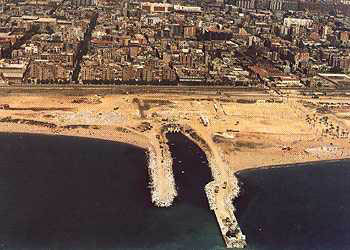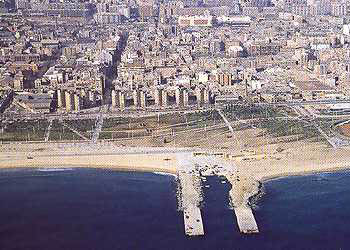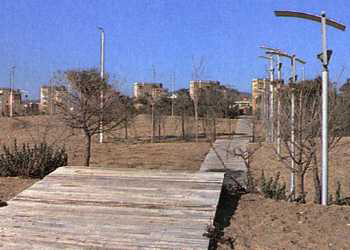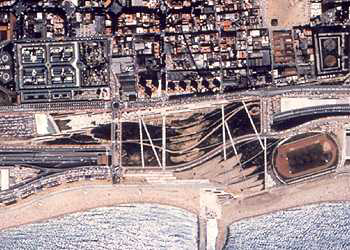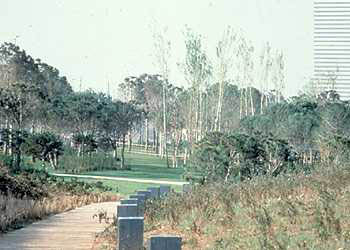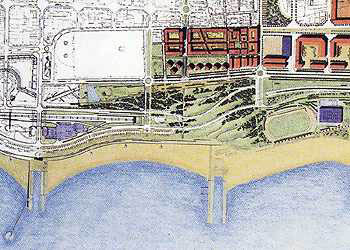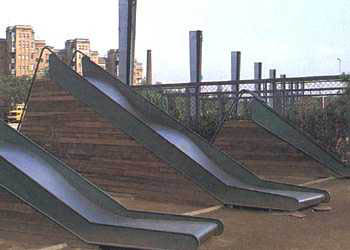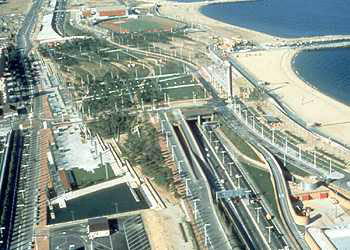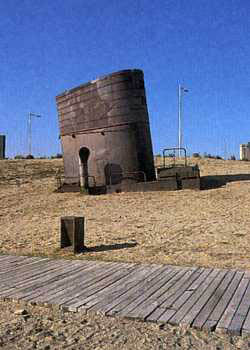Previous state
The site where the park now stands was occuped by successive build- ups of waste material, obsolete industrial facilities and a series of self-built dwellings. There was also the old Poble Nou goods station (with its series of platforms) and other elements from the city's former system of infrastructures (sewers, breakwaters and refuse tips). This was a marginalised space, segregated from the district it was named after.Aim of the intervention
The Parc del Poble Nou is located in Barcelona's new seafront area, near the original nucleus of the district it takes its name from, and in one of the urban areas which underwent the most comprehensive transformation as a result of the 1992 Olympic Games. The Poble Nou district was closely linked to the industrial development of the city from the nineteenth century onwards: a development which spread parallel to the Barcelona-Mataró railway line (the first railway line built in the Iberian Peninsula dating from 1848).The Seafront Development Plan defined two sectors: from the Barceloneta to the Vila Olímpica, and from the Parc del Mar to the mouth of the River Besòs. The urban frontage, the ring road -the Ronda del Litoral- as well as the treatment of different spaces and facilities in each of these zones led to two different solutions regarding ways of developing the site. The park was thus planned as a transitional space, laid out between the different stretches of road which pass through this place.
Description
The park occupies the area between the new Bogatell beach and the old Poble Nou -or Eastern- cemetery. It runs parallel to and, at the same time, over the Ronda del Litoral. The park consists of a sequence of dunes, covered with vegetation typical of the Mediterranean (pines and seaside vegetation), which stretches from the beach inland, and a network of crosswise pedestrian paths -towards the beach- and curvilinear paths which adapt to the topography and run lengthways. These paths have different types of surfacing according to their location and direction (wood, compact earth or coloured concrete). Zones which attract a great deal of acitivity, such as the children's play areas, sports tracks, bar, kiosks and public services are focused on the site of the disused railway line. The park is watered by an overhead sprinkler system which simulates the natural rainfall system, thus markedly reducing the effects of the salt characteristic of the seafront environment.Assessment
The park has added an unusual recreational area to the series of interventions carried out on the new Barcelona coastline. Besides the use of good design criteria and building methods, the park has contributed towards the overall development of one of the city's most neglected sectors. We must also appreciate the fact that the park has fostered the connection between the beach area and the old core of the district. Amongst the streets running perpendicular to it, the traditional and restored Rambla del Poble Nou comes out at the park. It is important to highlight the existence of a series of new facilities for the inhabitants which are linked to the park, such as the Pavelló de la Marbella, next to the seafront promenade -the Passeig Marítim-, the athletics track -isolated on a lower level- and the sailing centre which houses a municipal sailing school.Albert García Espuche, architect
[Last update: 02/05/2018]


